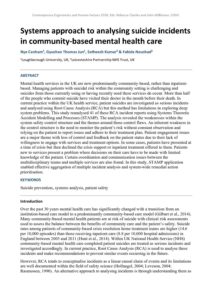| Document | Author Nye Canham, Gyuchan Thomas Jun, Satheesh Kumar & Fabida Noushad |
| Abstract Mental health services in the UK are now predominantly community-based, rather than inpatient-based. Managing patients with suicidal risk within the community setting is challenging and suicides from those currently using or having recently used these services do occur. More than half of the people who commit suicide have visited their doctor in the month before their death. In current practice within the UK health service, patient suicides are investigated as serious incidents and analysed using Root Cause Analysis (RCA) but this method has limitations in exploring deep system problems. This study reanalysed 41 of these RCA incident reports using Systems Theoretic Accident Modelling and Processes (STAMP). The analysis revealed the weaknesses within the system safety control structure and the themes around those control flaws. An inherent weakness in the control structure is the need to monitor the patient’s risk without constant observation and relying on the patient to report issues and adhere to their treatment plan. Patient engagement issues are a major theme with loss of control and feedback on the patient status due to their lack of willingness to engage with services and treatment options. In some cases, patients have presented at a time of crisis but then declined the crisis support or inpatient treatment offered to them. Patients new to services present a problem where decisions on their care have to be made with limited knowledge of the patient. Certain coordination and communication issues between the multidisciplinary teams and multiple services are also found. In this study, STAMP application enabled effective aggregation of multiple incident analysis and system-wide remedial action prioritisation. |

